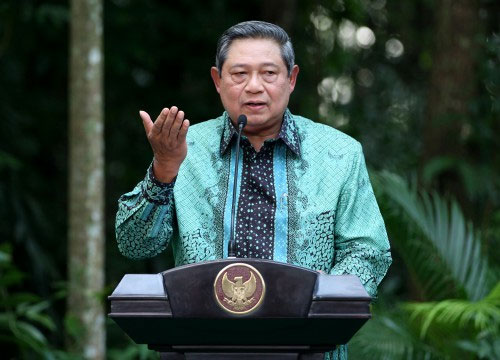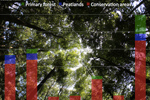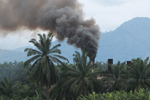 President Yudhoyono speaking during his address at the Center for International Forestry Research (CIFOR) in Bogor, Indonesia. (Photo: Dita Alangkara; courtesy of CIFOR) |
Indonesia “has reversed course” from a forest policy that drove deforestation in previous decades and is poised to become a leader in “sustainable forestry”, asserted Indonesian President Susilo Bambang Yudhoyono during a speech on Wednesday at the Center for International Forestry Research (CIFOR) in Bogor.
“Our forestry policy [in the 1970s and 1980s] was to allow anyone to cut our forests so long as it gave benefits to development,” he said. “It seemed the logical thing to do back then. We had lots of forests; we had to reduce poverty; we needed to grow our economy. As a result, there was a time when we experienced very serious deforestation.”
“Today, such a policy is no longer tenable. Losing our tropical rain forests would constitute the ultimate national, global and planetary disaster. That’s why Indonesia has reversed course by committing to sustainable forestry.”
President Yudhoyono highlighted the signing of a two-year moratorium on new logging and plantation concessions in some 14.5 million hectares of primary forests and peatlands; a new law that “would permanently conserve 35 percent of our tropical rain forests”, according to Yudhoyono; and the planting of some 3.2 billion trees under the ‘One Billion Indonesia Trees for the World program.’ Yudhoyono also noted his 2009 pledge to reduce emissions 26 percent below a projected 2020 business-as-usual baseline, a commitment that could rise to 41 percent with international assistance like that being provided by Norway.
But to some, his speech fell short, failing to outline specific targets for the Rio+20 conference, glossing over some concerns, and including some dubious math. For example, CIFOR Daniel Murdiyarso said that claims about emissions reductions from a drop in Indonesia’s deforestation rate may be premature.
“The challenge to meet the emission reduction target is not reducing the deforestation rate (hectare of deforestation per year). It is more important to reduce emission rates (ton of emissions per year). These are two different things,” he said in an interview conducted after the President’s speech. “If you reduce emissions in ecosystems with high carbon density, for example peat swamps, it does not need to involve a large area.”
Murdiyarso said the Indonesia would need to actually calculate “whether the avoided deforestation falls in the area that has a significant impact on reducing emissions.” Much of Indonesia’s current deforestation and degradation is occurring in carbon-dense peat forests, which are targeted for oil palm estates and pulp and paper plantations.
“Using my ‘back-of-the-envelope’ calculations, even if only half of the already licensed peatlands was fully protected from conversions, Indonesia would be better off to achieve a 26-percent target,” Murdiyarso explained. “Peatlands are the low-hanging fruits.”
 |
The President’s deforestation figures may also be overly optimistic. Last month the Ministry of Forestry asserted that Indonesia’s deforestation rate fell from 830,000 hectares per year between 2006-2009 to 450,000 hectares per year between 2009–2011. But the numbers haven’t been independently confirmed. Research by Matthew Hansen of the University of Maryland puts the deforestation rate in Kalimantan alone at 380,000 hectares a year in 2009 and 2010, with Sumatra also experiencing high rates of forest conversion and logging continuing on other Indonesian islands like Sulawesi and Indonesia’s half of New Guinea. Independent assessment of 2011’s deforestation rate is expected in the next few months, but is likely to reveal the Indonesia continues to have one of the highest deforestation rates in the world.
It was also unstated that the 3.2 billion tree-planting exercise cited by the President includes industrial plantations that have replaced native vegetation. Under the program, Indonesia targets planting a billion trees a year.
Yudhoyono did nonetheless have valid criticisms for the West, which has failed to curtail its own emissions and is so far providing only a fraction of the promised support for combatting deforestation and helping developing countries adopt greener growth models. Consumption in the West and other overseas markets like China is a major driver of deforestation and resource degradation in Indonesia.
“Not all developed countries which are the emitters of greenhouse gas have agreed to the Kyoto Protocol,” he said. “And the fact remains: many developed countries have failed to fulfill their commitments which were agreed in Kyoto. Also, programs that link efforts to reduce greenhouse gas emission with programs of technology transfer and poverty reductions in developing countries (non-annex) did not work as expected and targeted.”
“We need to ensure that the post-2015 framework of global development collaboration be built upon the principles of equality and open participation to all stakeholders. It must be aimed to empower the poor in developing countries. It must uphold the principles of cooperation and common responsibility that benefit all countries. And It must give greater role and access for emerging countries to participate actively in the efforts to reduce poverty and address environmental issues.”
Yudhoyono said progress toward emissions reductions would require consensus building between a wide variety of stakeholders. Any international climate framework would need to both reduce poverty and address environmental issues, while supporting “strong, balanced, inclusive, and sustainable economic growth.” He added that “No exploitation of resources should exceed its biological regenerative capacity.”
Yudhoyono concluded his speech with a call for “courage” and “creative” solutions to “the major issues of our time.” He said that Indonesia is emerging as a global leader in reducing emissions.
The full text of Yudhoyono’s speech is available at CIFOR’s blog.
Related articles
Indonesia revises moratorium map; makes contested orangutan forest off-limits

(05/22/2012) Indonesia is making ‘encouraging’ progress on its push to reduce deforestation by improving governance over its forests and peatlands, but still needs to do more to enforce environmental laws, said the head of the country’s Reducing Emissions from Deforestation and Degradation (REDD+) task force speaking at a press conference Monday in Jakarta. Kuntoro Mangkusubroto, Head of the Indonesian President’s Delivery Unit for Development Monitoring and Oversight (UKP4) and Chair of the REDD+ Task Force, said an effort to develop a map of Indonesia’s forests and forest concessions has been completed, although the Ministry of Forestry has yet to deliver the map to President Susilo Bambang Yudhoyono, missing last Friday’s deadline. The map serves as the basis for a two-year moratorium on new forestry concessions in primary forests and peatlands had been completed.

(07/27/2011) Indonesia’s forests were cleared at a rate of 1.5 million hectares per year between 2000 and 2009, reports a new satellite-based assessment by Forest Watch Indonesia (FWI), an NGO. Expansion of oil palm and wood-pulp plantations were the biggest drivers of deforestation, yet account for a declining share of the national economy. The study, which compared year 2000 data with 2009 Landsat images from NASA, found that Indonesia’s forest cover declined from 103.32 million hectares to 88.17 million hectares in ten years. Since 1950 Indonesia lost more than 46 percent of its forests.
Is Indonesia losing its most valuable assets?

(05/16/2011) Deep in the rainforests of Malaysian Borneo in the late 1980s, researchers made an incredible discovery: the bark of a species of peat swamp tree yielded an extract with potent anti-HIV activity. An anti-HIV drug made from the compound is now nearing clinical trials. It could be worth hundreds of millions of dollars a year and help improve the lives of millions of people. This story is significant for Indonesia because its forests house a similar species. In fact, Indonesia’s forests probably contain many other potentially valuable species, although our understanding of these is poor. Given Indonesia’s biological richness — Indonesia has the highest number of plant and animal species of any country on the planet — shouldn’t policymakers and businesses be giving priority to protecting and understanding rainforests, peatlands, mountains, coral reefs, and mangrove ecosystems, rather than destroying them for commodities?
Will Indonesia’s big REDD rainforest deal work?

(12/28/2010) Flying in a plane over the Indonesian half of the island of New Guinea, rainforest stretches like a sea of green, broken only by rugged mountain ranges and winding rivers. The broccoli-like canopy shows little sign of human influence. But as you near Jayapura, the provincial capital of Papua, the tree cover becomes patchier—a sign of logging—and red scars from mining appear before giving way to the monotonous dark green of oil palm plantations and finally grasslands and urban areas. The scene is not unique to Indonesian New Guinea; it has been repeated across the world’s largest archipelago for decades, partly a consequence of agricultural expansion by small farmers, but increasingly a product of extractive industries, especially the logging, plantation, and mining sectors. Papua, in fact, is Indonesia’s last frontier and therefore represents two diverging options for the country’s development path: continued deforestation and degradation of forests under a business-as-usual approach or a shift toward a fundamentally different and unproven model based on greater transparency and careful stewardship of its forest resources.